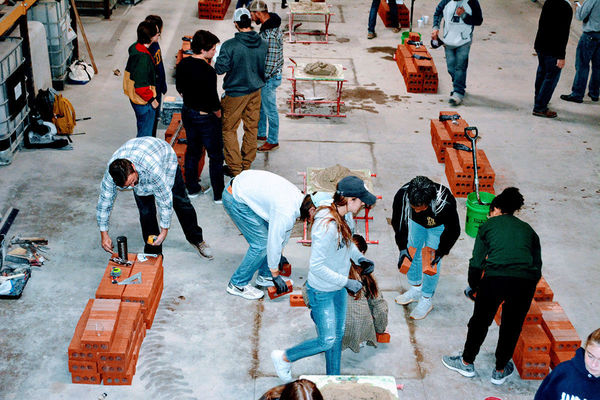 Architecture students working with masons
Architecture students working with masons
In the real world, working with contractors is a regular and essential part of the job as an architect. It’s for this reason that the School of Architecture values its annual Masonry Day when students spend the day at Kuert Concrete to collaborate on a building project with local masons.
The Masonry Day tradition dates back to 1985, and since its inception it has served as a practical complement to the instruction our students receive in the classroom. The entire sophomore class as well as graduate students enrolled in Building Tech I participated in the event, which was made possible by the generosity of various partnering sponsors such as Kuert Concrete, the International Masonry Institute, the International Union of Bricklayers and Allied Craftworkers, and Rose Brick & Materials.
“Masonry Day helps students develop a sensibility for the aesthetic, tectonic, and technical capabilities of brick as a building material,” said Michael Mesko, Visiting Professor of the Practice in the School of Architecture. “The project underscores the imperative of collaboration amongst design team members and expertise in the building trades to achieve a successful completed project.”
Prior to the event, students were broken up into small groups and given a week to design a monument to the School using no more than 300 bricks. Students brought their design plans to Kuert Concrete on the morning of the trip, and groups were set loose in the warehouse with five hours to construct their monuments.
Students didn’t work on their projects alone, though, as each group was assigned an apprentice mason to help guide them through the building process. The presence of masons served as an instructional resource to students, who gained a deeper appreciation of not just the uses and versatility of brick, but also of the technical skill and training required of masons to master it.
“It’s an opportunity for the apprentices to teach and for students to get practical experience,” said Kevin McClanahan, Field Representative at the International Union of Bricklayers and Allied Craftworkers. “The apprentices are there to help make their designs possible by fixing parts that might not actually work.”
A panel of judges made up of local architects, contractors, and designers evaluated each group’s finished product for quality of design and workmanship. Groups whose monuments placed at the top were awarded gift cards to supplement their bragging rights, with the first-place group being made up of Max Meuth, Sara Mshier, Lucas Misra, and Joan Ngai.
“The students learned a great deal working directly with masons as they executed and adapted their designs to factors encountered during construction, said Mesko. “There is no better way to understand a material than through the activity of building and with the guidance of experts in the field.”